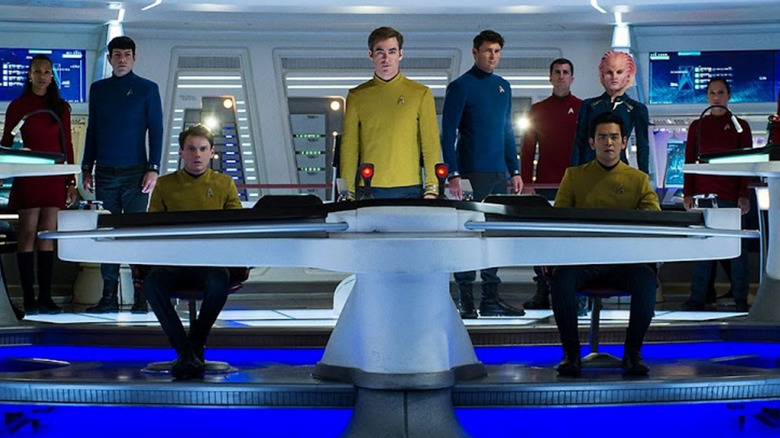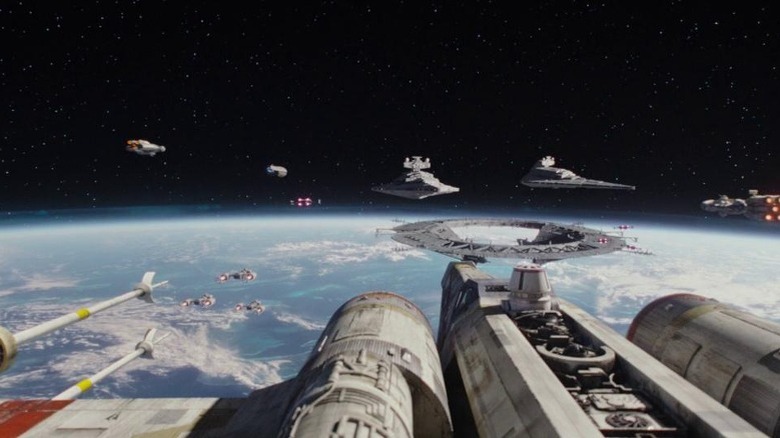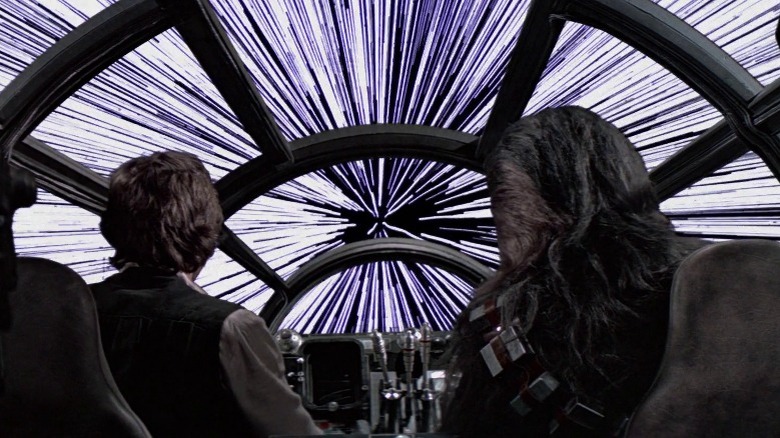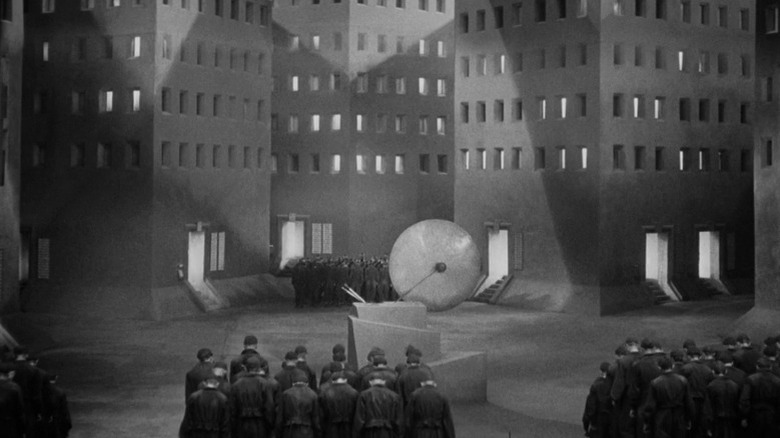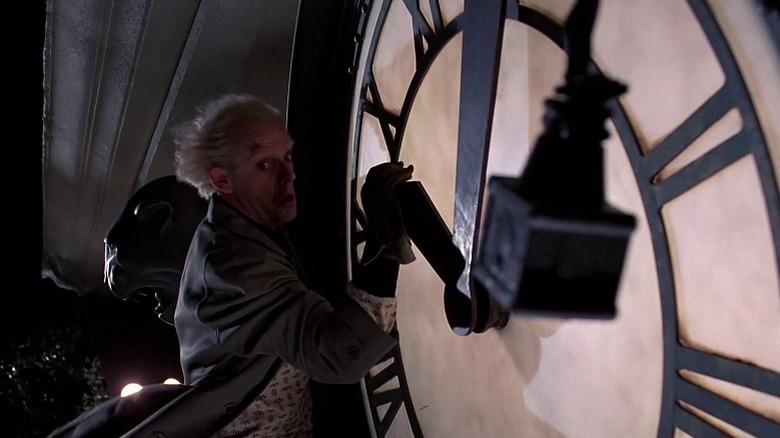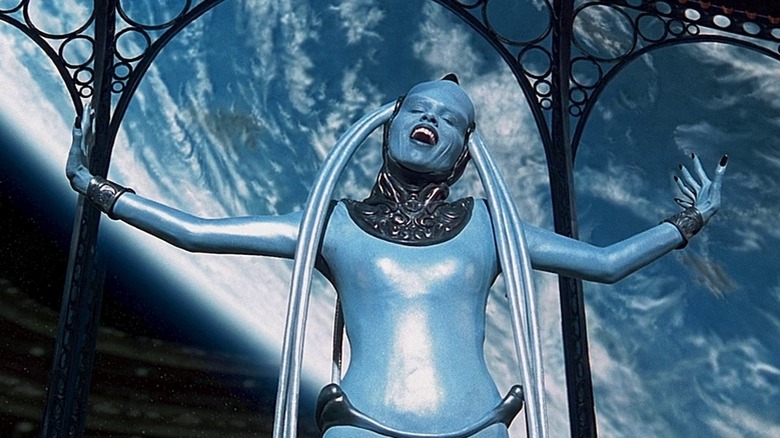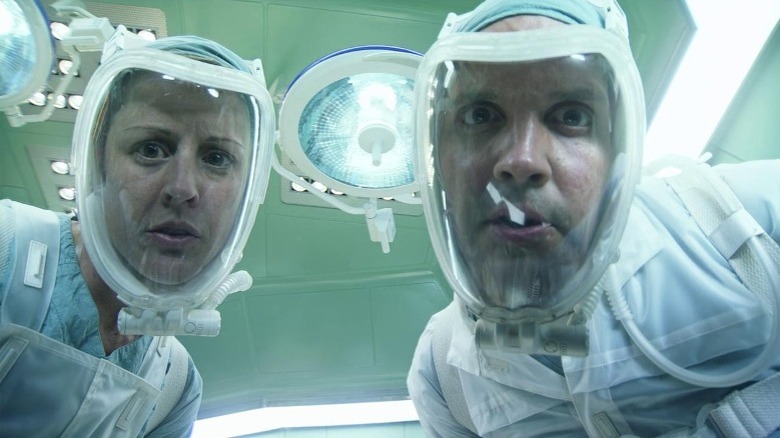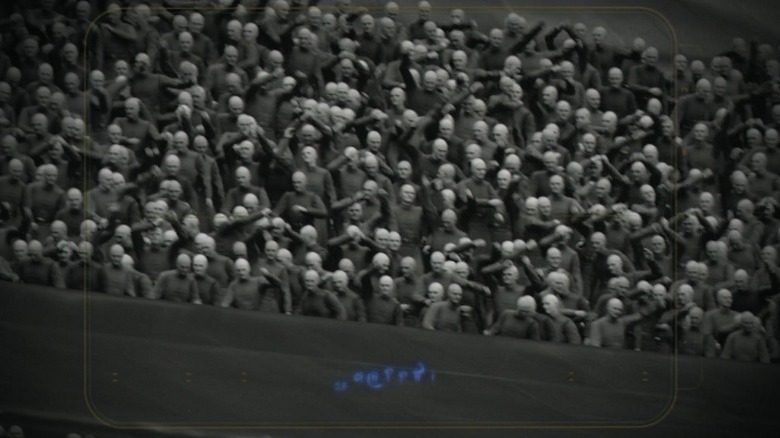11 Unwritten Rules That Every Sci-Fi Movie Has To Follow
The term "science fiction" is a funny one, when you really think about it. In the strictest terms, any given fictional story will feature science as a major driving force, either overtly or implicitly. If you limit the scope of sci-fi to stories that deal with speculative or anachronistic technology, that still doesn't quite cut it — there's plenty of sci-fi media that limits itself to the technology we have today. Even the emphasis on "science" doesn't feel quite right when so many staples of the genre, from "Frankenstein" to "Star Wars," are essentially fantasy.
The difficulty of coming up with a clear-cut, all-purpose description of what defines sci-fi, however, doesn't negate the fact that everyone knows sci-fi when they see it. It's something about that particular intersection of thematic interests — outer space, aliens, crazy tech, time travel, future and alternate visions of Earth, parallel dimensions — and the centuries that have been spent honing a particular way to explore them. There are, indeed, many unwritten rules that tend to crop up in sci-fi movies, and which might even contribute to making the genre so idiosyncratic and recognizable. To prove it, we've compiled 11 norms that guide many sci-fi films, which you may or may not have stopped to notice in your travels.
There's noise in space, even though there isn't in real life
The first unwritten rule that almost every sci-fi film abides by is a rule of artistic license: If there's outer space action going on, audiences need to be able to hear things as they happen. Therefore, there must be sound in space — even though that would be a physical impossibility in real life.
Sound is what classic physics defines as a mechanical wave: An oscillatory movement of matter, as opposed to the oscillations of magnetic and electric fields that make up electromagnetic waves like light. In other words, sound only exists where there is some kind of material medium for it to travel through, be it a gas, a liquid, or a solid. We hear things on Earth because the sound is traveling through the air in the atmosphere and moving its atoms and molecules. In outer space, conversely, there's no air for the sound to propagate in. Unlike light, sound can't exist in the vacuum — so an explosion or an impact or a blast observed from afar during a space battle would be completely silent.
The vast majority of space-set films pretend this isn't the case. For example, any given "Star Wars" film will feature nifty and boisterous sound effects in its space battle sequences. Realistic space sequences such as the breathtaking opening oner in "Gravity" might often seem bizarrely quiet as a result of that omnipresent rule, but they're just being scientifically accurate.
Faster-than-light travel must have been conquered
Nothing in the known universe can travel faster than light. As a matter of fact, the theory of relativity postulates that faster-than-light travel is physically impossible. When it comes to matter — i.e., particles and objects with mass — we know that the faster something is traveling, the greater its mass becomes, and traveling at the speed of light would make an object so massive that the amount of energy required to move it would be infinite. All theoretical models of faster-than-light movement imagine warping space itself to create "shortcuts" from one place to another; linear vehicular movement, such as that of a spaceship, simply cannot reach lightspeed, let alone surpass it.
If sci-fi stories were limited by that scientific knowledge, however, they'd become significantly tricky to write. Light travels extremely fast, but not fast enough to get from one solar system to another in less than a few years or decades; even the nearest star to our Sun, Proxima Centauri, is over four lightyears away. The only way for a galaxy to be explored and traversed by spacecrafts as easily and quickly as the Earth's surface is traversed by ships and airplanes — a requirement in stories about interstellar contact and galactic federations and whatnot — would be if all known laws of physics were defied, and ships were somehow able to travel much faster than light. Thus, all space opera films must feature faster-than-light travel technology.
The future is never bright
A staple of the sci-fi genre is its penchant for speculation about humanity's future. Many, if not most, sci-fi films featuring humans take place at some point in the future, whether that future is decades or millennia removed from when the movie is made, or it's still a long ways away from our present day, like the long-abandoned earth of "WALL-E." In most depictions of the world to come, the filmmakers' forecasts are not exactly optimistic.
We've pretty much gotten used to dystopias as the order of the day in cinematic visions of what lies ahead. Looking back on sci-fi history, pessimistic depictions of the future became extremely prevalent from the '60s onward, to the point where any given movie set in a futuristic human society is now expected to carry some measure of darkness and social dysfunction, if not an outright post-apocalyptic framing.
Even in the arguably best-known optimistic future in sci-fi — the world of "Star Trek" — humans are shown to have gone through a devastating World War III and a long nuclear winter before rising from the ruins to form a better society. It seems that, at some point in the 20th century, our fiction was utterly overcome with fear that tomorrow would exacerbate the problems of today. There are notable exceptions, though — 2015's "The Martian," for instance, is pretty much an ad for humanity's potential to bring technology and solidarity together.
All societies are hardcore plutocracies
Following on from the fact that most depictions of the future in the past few decades of film history have leaned negative if not dystopian, we could also point to the specific nature of most dystopias as an unwritten rule of sci-fi. This is a rule that doesn't just apply to speculative futures either, as it informs even the completely fantastical realm of a long time ago in a galaxy far, far away. The rule is this: Sci-fi societies, whether future visions of Earth or completely distinct civilizations in other planets or dimensions, are usually stratified between the ultra-rich and the poor who work in dire conditions to sustain them, with little to no in-between.
You see it even in the relatively kid-friendly world of "Star Wars," where the ruling plutocracy eventually gives rise to the Empire and later the First Order, all funded by wealthy warmongers, while the poor and downtrodden are exploited and oppressed all over the galaxy. The archetypal sci-fi epic, 1927's "Metropolis," literally structures itself by vertically contrasting the rich industrialists who live in the skyscrapers and the proletarians who toil away at ground level. "The Hunger Games" makes it as plain as possible with the war between the Capitol and the districts. The few sci-fi films in which a significant middle class exists are usually set in the present, in the very near future, or in worlds closely mirroring our own; the further into the future we get, the less distributed wealth seems likely to be.
There's always different slang and a different currency
There are lots of tools a sci-fi film can use to build out its world and make it richer, more detailed, and more immersive. Two especially popular ones seem to be the creation of a future currency and the peppering of dialogue with fantastical, in-universe slang terms.
In a lot of sci-fi films, especially those set in the distant future, exchanges are made in "credits." "Star Wars" has Republic credits and Imperial credits, "Total Recall" features charges made in credits, and Sylvester Stallone's character in "Demolition Man" is fined in credits. Then there are currencies with other names such as "units" in "Guardians of the Galaxy" and "Amero" in "Elysium" and "space bucks" in "Spaceballs," pragmatic currencies like car fuel in the "Mad Max" franchise, and utterly unusual currencies like the one in the world of "In Time," where people stop aging at 25 and then proceed to get paid or pay, well, in time.
As for the made-up slang, it's a very common world-building device in fantasy, so it stands to reason that it would be equally common in sci-fi. Max Rockatansky in "Mad Max: Fury Road" is deemed "a crazy smeg who eats schlanger," drug addicts in "Back to the Future'"s 2015 are "tranks," and characters in "The Fifth Element" compliment things and people by calling them "green." Then there's the subject of sci-fi slurs, such as calling androids "skin-jobs" in "Blade Runner," which is a whole other can of worms.
There must be a certain looseness to time travel
The moment a story starts playing with time travel as a plot device, it pretty much immediately begins to wade into paradoxes and logical impossibilities. Travel into the past, and anything at all you do — even just occupying space where air used to be — will inevitably alter the fabric of the world in such a way as to create repercussions for the future, possibly leading to a world in which you would have never traveled into the past in the first place. Travel into the future, and any possibility of going back to your time will now have paradoxical consequences as well. Rewind time and your consciousness will have untethered itself from linear existence; jump physically into the past and you risk becoming your own grandfather.
To avoid the innumerable logistical issues that would arise from a 100% consistent and well-defined set of cause-and-effect rules, most movies about time travel will play fast and loose with the concept — sometimes even nodding to potential "alterations in the timeline" and ensuing problems, but not really mapping everything out with scientific stringency. Unsurprisingly, when the Marvel Cinematic Universe's notoriously grounded and real-world-adjacent plot culminated in back-to-the-past antics in "Avengers: Endgame," the film made a point of clarifying that the characters were not traveling back in time, but visiting certain moments in parallel universes and creating new timelines — a concept with some real science behind it and one that allows "time travel" to slot comfortably into the MCU's dense mythology.
Everyone in space is conveniently human-like
In addition to humans, the "Star Wars" films have given us wookiees like Chewbacca, Togruta like Ahsoka, gungans like Jar Jar Binks, pointy-eared green beings like Yoda and Grogu (whose name fans should not ignore), jawas, ewoks, Rodians ... the list goes on and on. All those species are vastly different from each other, yet they all have some things in common: Hands, feet, an endoskeleton, a head with eyes and ears and a nose and a mouth, motor skills, some form of speech, and of course, sentience similar to ours. In other words, they're all mammal-like, if not outright primate-like in anatomy and bodily functions, and human-like in mind.
If you extend that line of thought to all sci-fi cinema, it's startling how many of the alien species that humans interact with, even in the furthest confines of the galaxy, are essentially remixed humans. The Na'vi in "Avatar" are so close to us that we can inhabit bodies like theirs with just a little adaptation; most alien species in the "Star Trek" world are humanoid enough to be played by human actors wearing prosthetic makeup; even deadly monsters like the Xenomorphs are pretty similar to Earth wildlife in the grand scheme of things. In fact, when aliens do depart radically from the kind of life we know, such as the ones in "Arrival" or "2001: A Space Odyssey" or "The Thing" or "Edge of Tomorrow," humanity's difficulty understanding and dealing with them is often a major plot point.
Almost every inhabited planet is a lot like Earth
Though life can be infinitely varied, alien lifeforms in most sci-fi films always seem to fit within the parameters of animal life that we have on Earth, inhabited planets and moons found beyond our solar system are generally pretty similar to our own mother planet. Astronomers have yet to find a planet in the observable universe with an atmosphere that humans could breathe in and not be pressure-crushed by, but, in science fiction, those planets exist in spades, whether naturally or made that way through terraforming technology. In either case, they usually have near-identical gravity to Earth's, too. A lot of planets in sci-fi movies will even have Earth-like weather phenomena and water availability, and maybe a familiar biosphere with edible flora and fauna as well.
It's understandable why most sci-fi uses that shortcut, since it's either that or forcing human characters to wear protection suits at all times — to say nothing of the trouble of creating completely otherworldly environments and sets. It could be argued that there's an element of realism to this unwritten rule, given that planets with Earth-like characteristics might be more hospitable to the development of human-esque life. In that sense, this rule and the "all aliens are humanoid" rule go hand in hand, as the fact that aliens are usually similar to us means that it would make more sense for them to hail from environments similar to ours.
Medicine is rarely as advanced as other technology
For all their dystopian horrors and injustices on a societal level, futuristic societies in sci-fi movies are usually teeming with so much incredibly advanced technology that we end up taking a lot of it for granted. Interstellar travel alone is a miracle by all contemporary scientific standards, but you don't even need to go that far to find typical tech in sci-fi to marvel at. The "nanotechnology" used for all kinds of purposes from suit construction in "Black Panther" to software infiltration in the "Terminator" franchise is so unimaginably advanced as to pretty much cross from sci-fi to fantasy, and even the ever-so-common plot of androids and artificial intelligences developing sentience would require much more advanced algorithms and much greater energy efficiency than what computer science can currently offer.
Yet there's one department where the imaginations of sci-fi filmmakers seldom seem to march that gleefully towards the fantastical: medicine. In any civilization technologically advanced enough to have invented faster-than-light spaceships and nanites and robots with a soul, it stands to reason that a lot of problems we have to deal with in contemporary medicine would have become a thing of the past; wounds of all kinds would be a lot more treatable, most ailments would probably be eradicated, and even humans' average lifespan might be drastically increased. So how come movies set in high-tech worlds will still have characters die by gunshot to the torso or heart attack or some such 21st-century inconvenience?
Every story about androids is just Pinocchio
You'd think that developing sentience and becoming an intelligent entity with full agency and autonomy would be enough for some people. But, in so many decades of science fiction focused on androids and robots, it seems that the central underlying conflict has never changed much. To this day, almost all android films are still essentially "Pinocchio" reimaginings: All they want is to be truly human.
It's almost narcissistic of us, really, to imagine that an intelligent mind not bound by the biological and psychological constraints of human life would crave nothing more than to live as though they were constrained. Artificial sentience would be a fundamentally different kind of sentience: Freed from the pains and frailties and limitations of organics, yet also stripped of its assets and delights and galvanizing mysteries. It wouldn't necessarily be better or worse than being human, but it certainly wouldn't be just a facsimile trying to prove itself equal.
Many sci-fi films needlessly belabor the point of whether or not artificially sentient beings "have a soul." From the beginning, it's plain to viewers that they do, for all intents and purposes. Rarely do filmmakers instead explore the question of what it would mean for a soul to occupy a non-human vessel, what specific possibilities and conflicts that could engender. It's part of the reason "Her" was such a beautiful, original look at humanity and love. Samantha and the other OSs eventually grow far, far beyond the reach of human sentience. Few films are willing to confront that humbling possibility head-on.
Other civilizations are usually monocultural
How absurd would it be to attempt to fit all nations, peoples, ethnicities, and languages that exist or have existed on Earth across the tens of thousands of years of human civilization into the singular umbrella of "human culture" as we know it? Pretty absurd, right? Yet many sci-fi filmmakers seem all too keen on resorting to such broad strokes when painting extraterrestrial civilizations.
It doesn't matter if it's a planet as big as the Earth, if the civilization in question has as many members as the Earth has humans, or if it's been around for an equivalent amount of time. If a movie features multiple planets each with a unique set of alien inhabitants, it's likely that at least one of them will be reduced to a monocultural simplification in order to be more easily processed by viewers.
Thus, the nations in "Dune" occupy entire planets and have mostly homogeneous cultures. Aladna in "The Marvels" is a musical planet; the Vogons in "The Hitchhiker's Guide to the Galaxy" are somehow all annoying bureaucrats; the MCU's Asgard is near-uniformly Norse-inspired; the Yautja in the "Predator" franchise seem to all be single-minded hunters; and both the "Star Wars" and "Star Trek" franchises feature entire civilizations defined by traits like "helmet-wearing warriors" and "strict followers of logic." It would seem that cultural diversity is a privilege of earthlings — in fact, lots of sci-fi media specifically single out diversity as our defining trait, the very thing that makes us unique and special. If only everyone on Earth had the good sense to cherish it.
